1997 PONTIAC GRAND AM ignition
[x] Cancel search: ignitionPage 34 of 371
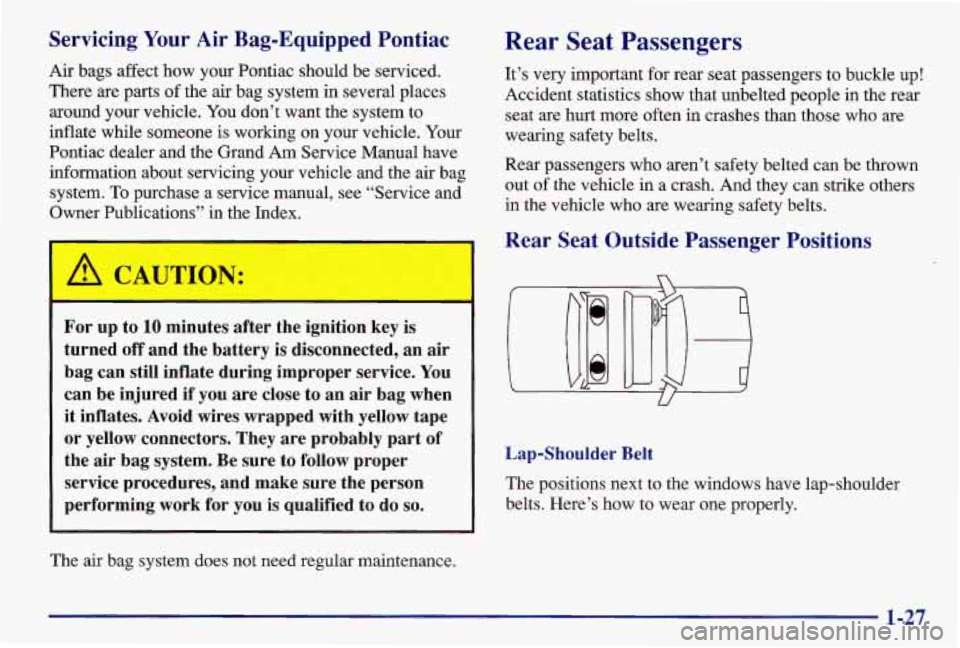
Servicing Your Air Bag-Equipped Pontiac
Air bags affect how your Pontiac should be serviced.
There are parts
of the air bag system in several places
around your vehicle. You don’t want the system to
inflate while someone is working on your vehicle. Your
Pontiac dealer and the Grand Am Service Manual have
information about servicing your vehicle and the air bag
system. To purchase a service manual, see “Service and
Owner Publications” in the Index.
I A I
/! CAUTION:
For up to 10 minutes after the ignition key is
turned off and the battery is disconnected, an air
bag can
still inflate during improper service. You
can be injured if you are close to an air bag when
it inflates. Avoid wires wrapped with yellow tape
or yellow connectors. They are probably part of
the
air bag system. Be sure to follow proper
service procedures, and make sure the person
performing work for you
is qualified to do so.
The air bag system does not need regular maintenance.
Rear Seat Passengers
It’s very important for rear seat passengers to buckle up!
Accident statistics show that unbelted people in the rear
seat are hurt more often in crashes than those who are
wearing safety belts.
Rear passengers who aren’t safety belted can be thrown
out of the vehicle in a crash. And they can strike others
in the vehicle who are wearing safety belts.
Rear Seat Outside Passenger Positions
U
Lap-Shoulder Belt
The positions next to the windows have lap-shoulder
belts. Here’s how to wear one properly.
1-27
Page 56 of 371

Section 2 Features and Controls
Here you can learn about the many standard and optional features on your Pontiac, and information on starting,
shifting and braking. Also explained are the instrument panel and the warning systems that tell you if everything is
working properly
-- and what to do if you have a problem.
2-2 2-4
2-7
2-
10
2-12 2-13 2-13
2-
14
2- 16
2-19
2-2
1
2-25
2-28
2-29
2-3
1
Keys
Door Locks
Keyless Entry System (If Equipped)
Trunk
Theft
Passlock
TM
New Vehicle “Break-In”
Ignition Positions Starting Your Engine
Engine Coolant Heater (If Equipped)
Automatic Transaxle Operation
Manual Transaxle Operation
Parking Brake Shifting Into PARK (P) (Automatic Transaxle
Models Only) Shifting Out of PARK (P) (Automatic
Transaxle Models Only) 2-3
1
2-32
2-32
2-33
2-34
2-35
2-35 2-43
2-48
2-50
2-52
2-53
2-53
2-54
2-58
Parking Your Vehicle
(Manual Transaxle Only)
Parking Over Things That Burn
Engine Exhaust Running Your Engine While You’re Parked
(Automatic Transaxle)
Windows
Tilt Wheel (If Equipped)
Turn SignaUMultifunction Lever
Exterior Lamps
Mirrors Storage Compartments
Accessory Power Outlet
Garment Hook
Sunroof (If Equipped)
The Instrument Panel
--
Your Information System
Warning Lights, Gages and Indicators
2-1
Page 57 of 371
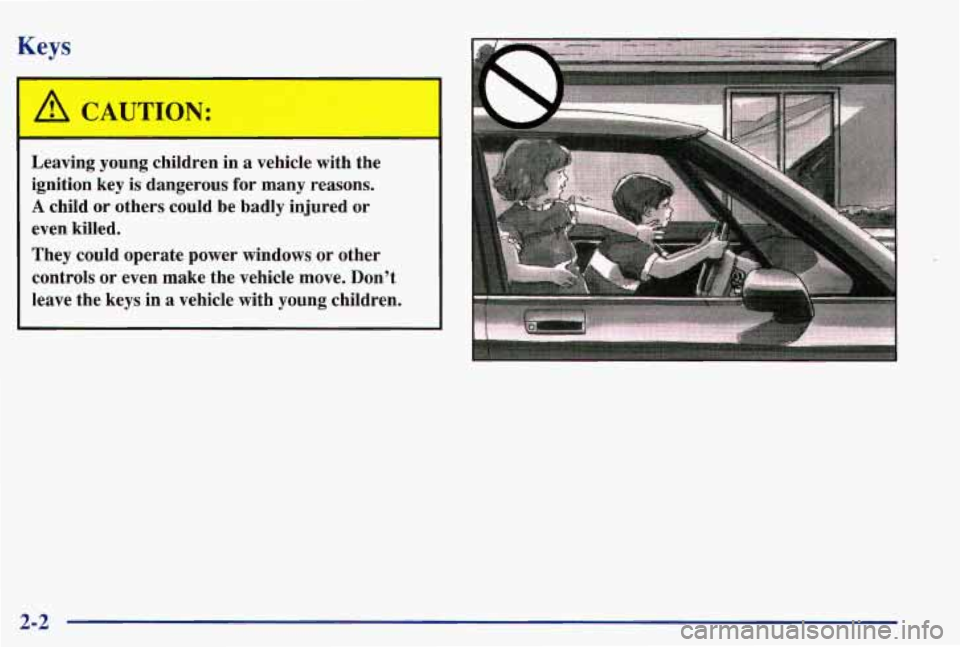
Keys
A CAUTION:
Leaving young children in a vehicle with the
ignition key
is dangerous for many reasons.
A child or others could be badly injured or
even killed.
They could operate power windows or other
controls or even make the vehicle move. Don’t
leave the keys in a vehicle with young children.
.* ...... ....... ........ >..* ..o..*..*.L..L...
2-2
Page 58 of 371
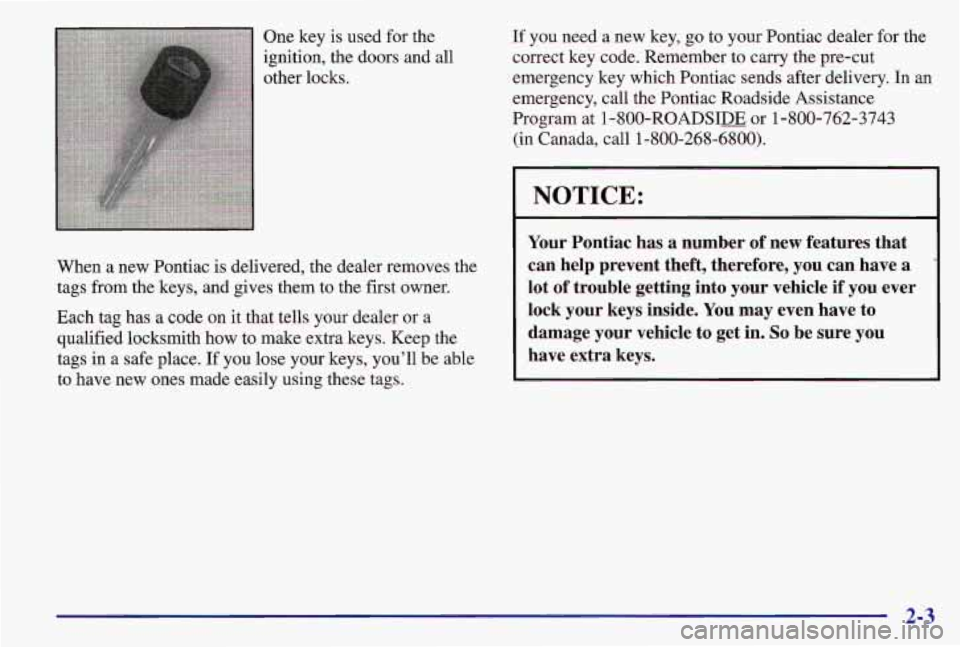
One key is used for the
ignition, the doors and all
other locks. If you need
a new key, go to your Pontiac dealer for the
correct key code. Remember to carry the pre-cut
emergency key which Pontiac sends after delivery. In an
emergency, call the Pontiac Roadside Assistance
Program at
1 -800-ROADSIE or 1-800-762-3743
(in Canada, call 1-800-268-6800).
When a new Pontiac is delivered, the dealer removes the
tags from the keys, and gives them to the first owner.
Each tag has a
code on it that tells your dealer or a
qualified locksmith how to make extra keys. Keep the
tags in a safe place.
If you lose your keys, you’ll be able
to have new ones made easily using these tags.
I NOTICE:
Your Pontiac has a number of new features that
can help prevent theft, therefore, you can have a
lot of trouble getting into your vehicle if you ever
lock your keys inside. You may even have to
damage your vehicle
to get in. So be sure you
have extra keys.
2-3
Page 60 of 371
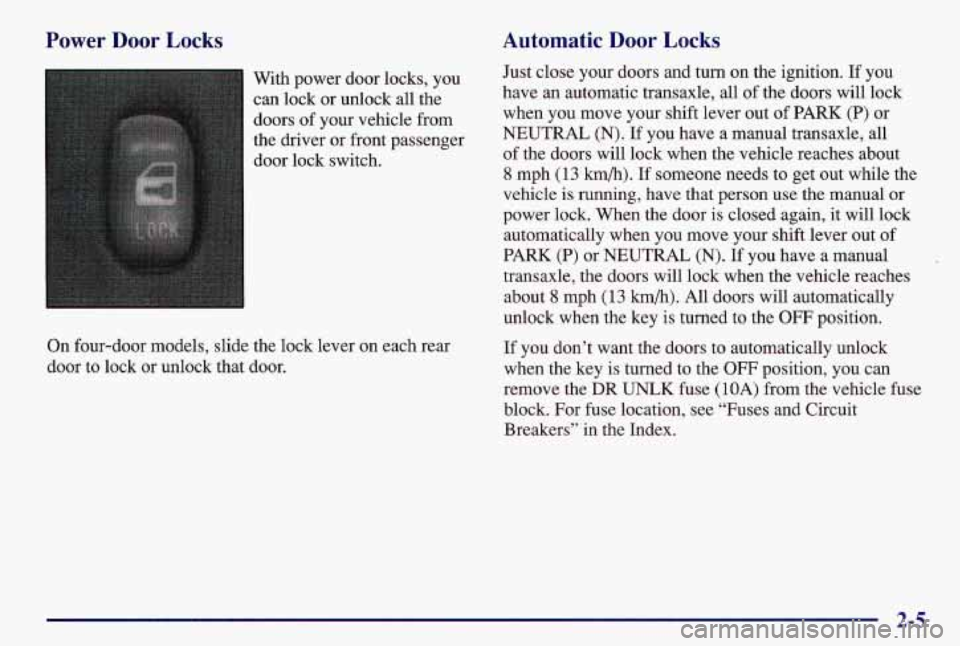
Power Door Locks
With power door locks, you
can lock or unlock all the
doors of your vehicle from
the driver or front passenger door lock switch.
On four-door models, slide the lock lever on each rear
door to lock or unlock that door.
Automatic Door Locks
Just close your doors and turn on the ignition. If you
have an automatic transaxle, all of the doors will lock
when
you move your shift lever out of PARK (P) or
NEUTRAL (N). If you have a manual transaxle, all
of the doors will lock when the vehicle reaches about
8 mph (13 km/h). If someone needs to get out while the
vehicle is running, have that person use the manual or
power lock. When the door is closed again,
it will lock
automatically when you move your shift lever out
of
PARK (P) or NEUTRAL (N). If you have a manual
transaxle, the doors will lock when the vehicle reaches about
8 mph (13 km/h). All doors will automatically
unlock when the key
is turned to the OFF position.
If you don’t want the doors to automatically unlock
when the key
is turned to the OFF position, you can
remove the DR UNLK fuse (1OA) from the vehicle fuse
block. For fuse location, see “Fuses and Circuit
Breakers” in the Index.
2-5
Page 63 of 371
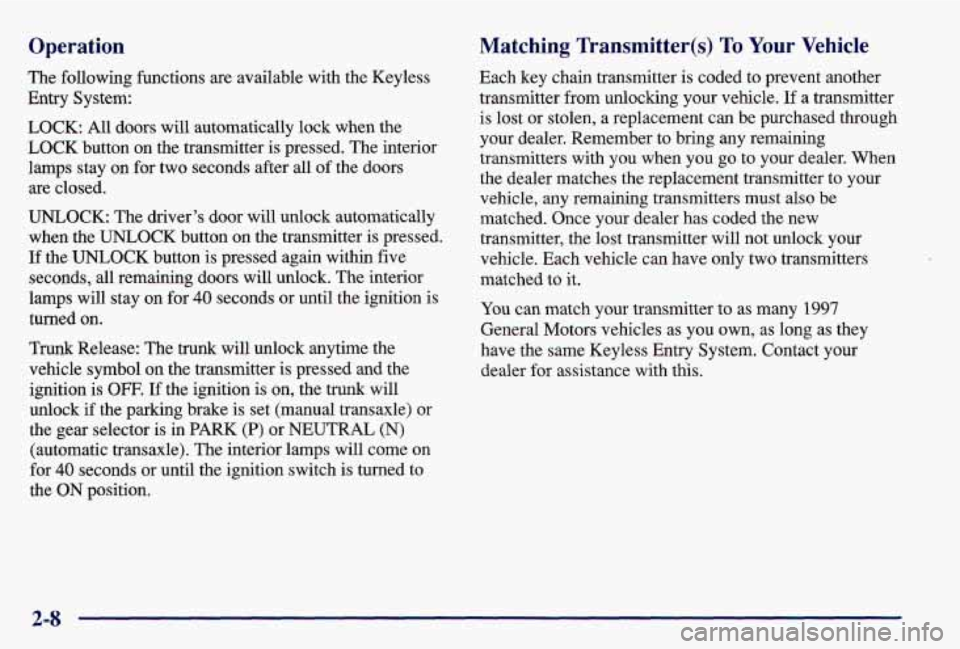
Operation
The following functions are available with the Keyless
Entry System:
LOCK: All doors will automatically lock when the
LOCK button on the transmitter is pressed. The interior
lamps stay on for two seconds after all of the doors
are closed.
UNLOCK: The driver’s door will unlock automatically
when the UNLOCK button on the transmitter is pressed.
If the UNLOCK button is pressed again within five
seconds, all remaining doors will unlock. The interior
lamps will stay on for
40 seconds or until the ignition is
turned on.
Trunk Release: The trunk will unlock anytime the
vehicle symbol
on the transmitter is pressed and the
ignition is
OW. If the ignition is on, the trunk will
unlock
if the parking brake is set (manual transaxle) or
the gear selector
is in PARK (P) or NEUTRAL (N)
(automatic transaxle). The interior lamps will come on
for 40 seconds or until the ignition switch is turned to
the
ON position.
Matching Transmitter(s) To Your Vehicle
Each key chain transmitter is coded to prevent another
transmitter from unlocking your vehicle.
If a transmitter
is lost or stolen, a replacement can be purchased through
your dealer. Remember to bring any remaining
transmitters with you when you go to your dealer. When
the dealer matches the replacement transmitter to your
vehicle, any remaining transmitters must also be
matched. Once your dealer has coded the new
transmitter, the lost transmitter will not unlock your
vehicle. Each vehicle can have only two transmitters
matched to it.
You can match your transmitter to as many 1997
General Motors vehicles as you own, as long as they
have the same Keyless Entry System. Contact your
dealer for assistance with this.
2-8
Page 67 of 371
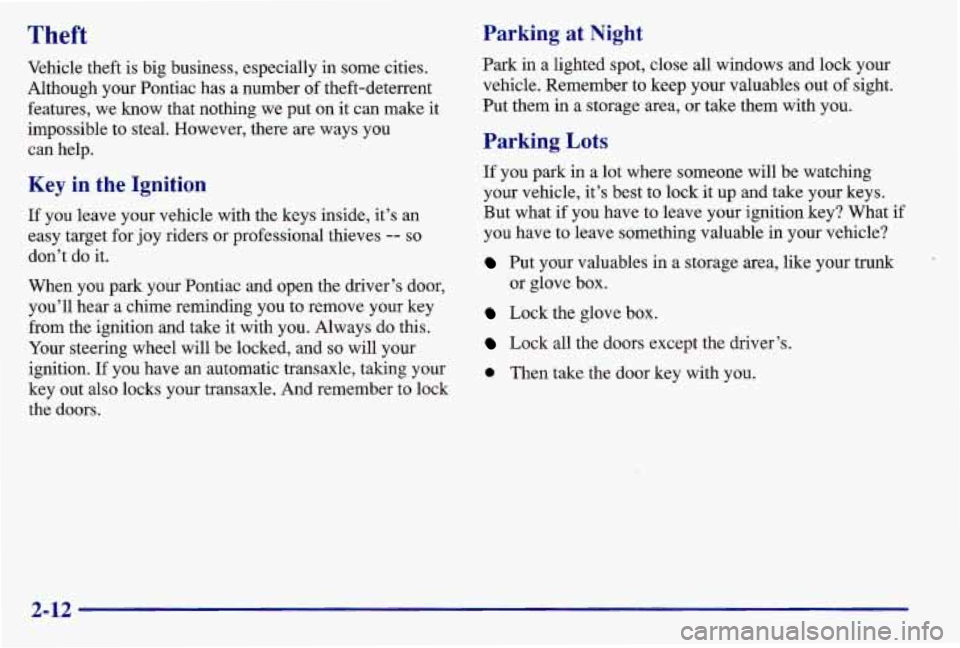
Theft Parking at Night
Vehicle theft is big business, especially in some cities.
Although your Pontiac has a number of theft-deterrent
features, we know that nothing we put on it can make it
impossible to steal. However, there are ways you
can help.
Key in the Ignition
If you leave your vehicle with the keys inside, it’s an
easy target for joy riders or professional thieves
-- so
don’t do it.
When you park your Pontiac and open the driver’s door, you’ll hear a chime reminding you to remove your key
from the ignition and take it with you. Always do this.
Your steering wheel will be locked, and
so will your
ignition.
If you have an automatic transaxle, taking your
key out also locks your transaxle. And remember to lock the doors. Park in a lighted spot, close all windows and lock your
vehicle. Remember to keep your valuables out of sight.
Put them in a storage area, or take them with you.
Parking Lots
If you park in a lot where someone will be watching
your vehicle, it’s best to lock it up and take your keys.
But what if you have to leave your ignition key? What if
you have to leave something valuable in your vehicle?
Put your valuables in a storage area, like your trunk
or glove box.
Lock the glove box.
Lock all the doors except the driver’s.
e Then take the door key with you.
2-12
Page 68 of 371

Passlock TM
Your vehicle is equipped with the Passlock
theft-deterrent system.
Passlock is a passive theft-deterrent system. The system is
armed once the key is removed from the ignition. Passlock
enables fuel if the ignition lock cylinder is turned with a valid key.
If a correct key is not used, fuel is disabled,
During normal operation, the THEFT SYS light will go
off after the engine is started. If the engine stalls and the
THEFT SYS light flashes, wait until the light stops
flashing before trying to restart the engine. Remember to
release the key from the START position as soon as the
engine starts. If you are driving and the THEFT
SYS
light comes on, you will be able to restart the engine if
you turn the engine off. However, your Passlock system
is not working properly and must be serviced by your
dealer. Your vehicle is not protected by Passlock at this
time.
You may also want to check the fuse (see “Fuses
and Circuit Breakers” in the Index). See your Pontiac
dealer for service.
If the THEFT SYS light comes on while the engine is
running,
a problem has been detected and the system
may need service. See your dealer for service.
In an emergency, call the Pontiac Roadside Assistance
Center at 1-800-ROADSIB or 1-800-762-3743.
New Vehicle “Break-InSS
NOTICE:
Your modern Pontiac doesn’t need an elaborate
“break-in,” But it will perform better in the long
run
if you follow these guidelines:
0
0
0
Don’t drive at any one speed -- fast or
slow
-- for the first 500 miles (805 km).
Don’t make full-throttle starts,
Avoid making hard stops for the first
200 miles (322 km) or so, During this time
your new brake linings aren’t yet broken
in. Hard stops with new linings can mean
premature wear and earlier replacement.
Follow this breaking-in guideline every
time you get new brake linings,
Don’t tow
a trailer during break-in,
See “Towing a Trailer” in the Index for
more information.
2-13